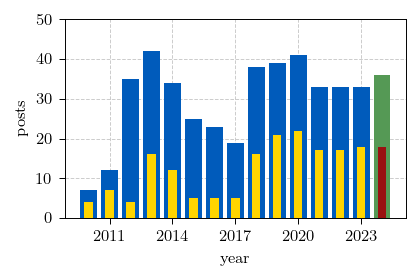Happy New Year! It is time for our yearly reflection. Unexpectedly, we just
had another good year on Physics of Risk. At least content-wise. We have
published 36 posts (+3 in comparison to the previous
year). Half of the posts, 18 in
total, were supplemented by interactive
materials. Overall trend remains more-or-less
stable as can be seen from the plot below.
Exploring random telegraph noise has led us
to explore some related topics in statistics. Namely, we
have shown that power-law distributions can be manufactured by using
mixtures of other distributions. Reviewer comments on our recent paper [1] have prompted a quick look at the core concept
in statistical physics - Fermi-Dirac
statistics.
Summer vacation has served as a reset. I have restarted with a rant about
the state of open science, and general tutorial videos, but quickly switch
to a few unrelated topics in statistics and opinion
dynamics. Finally, we have started talking about
Colonel Blotto game, which we will continue
this year. I would also like to write a post or two about another recent
paper by me and coauthors from Faculty of Mathematics and
Informatics [2]. And
then... we will see what comes!
References
- A. Kononovicius, B. Kaulakys. 1/f noise in semiconductors arising from the heterogeneous detrapping process of individual charge carriers. Journal of Statistical Mechanics 2024: 113201 (2024). doi: 10.1088/1742-5468/ad890b. arXiv:2306.07009 [math.PR].
- A. Kononovicius, R. Astrauskas, M. Radavičius, F. Ivanauskas. Delayed interactions in the noisy voter model through the periodic polling mechanism. Physica A 652: 130062 (2024). doi: 10.1016/j.physa.2024.130062. arXiv:2403.10277 [physics.soc-ph].

